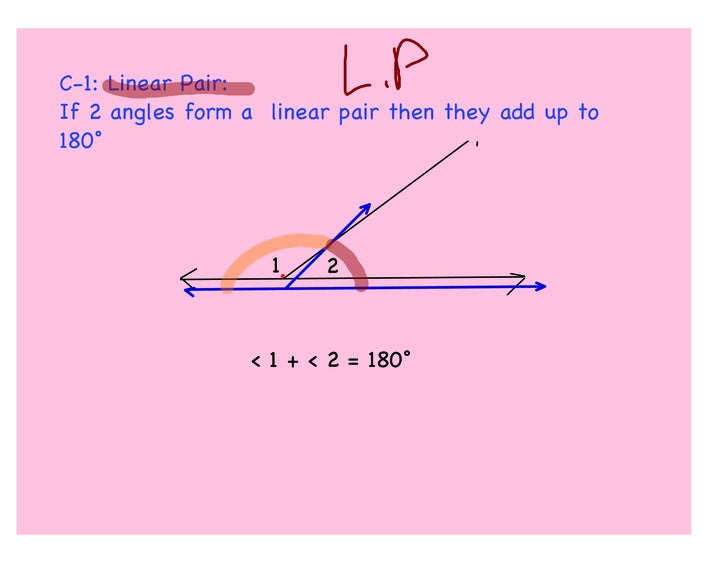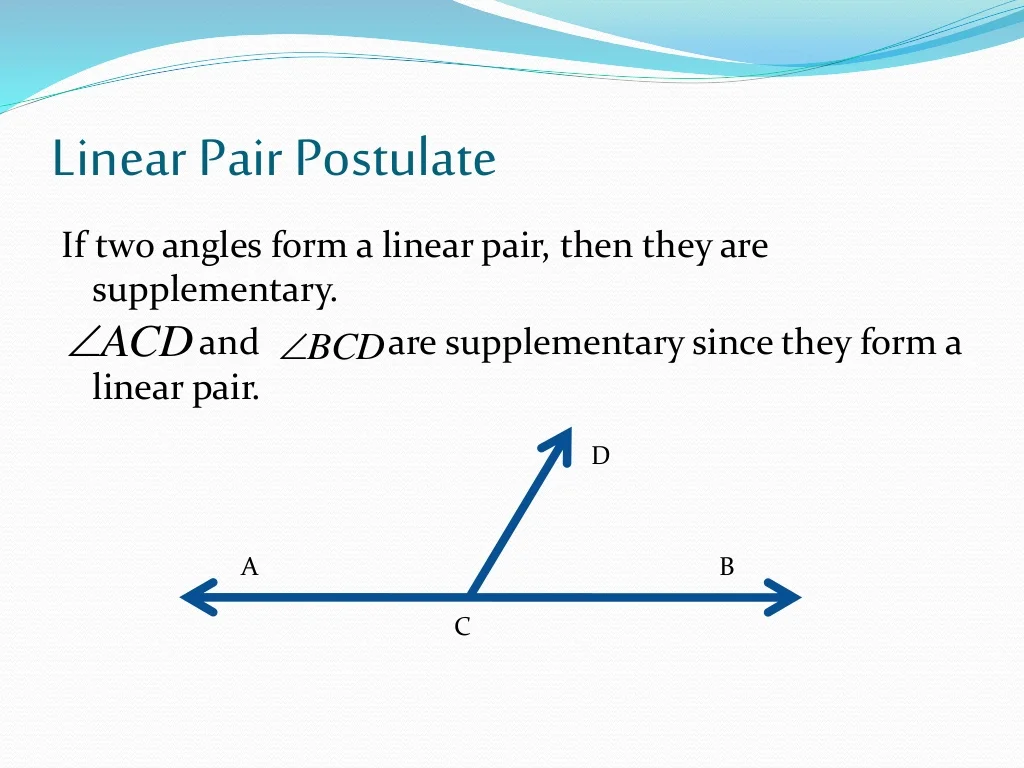1 And 2 Form A Linear Pair
1 And 2 Form A Linear Pair - In the diagram above, ∠abc and ∠dbc form a linear pair. ∠1 and ∠3 are vertical angles. ∠2 and ∠3 form a linear pair. ∠1 and ∠2 are supplementary, and ∠2 and ∠3 are supplementary. The angles are adjacent, sharing. Web asked • 10/06/20 <<strong>1 and <2 form a linear pair</strong>. Where a or b can be zero, but not both at the same time. The graph of the equation is a straight line,. What is the measure of angle 2? The equation is usually written so that a ≥ 0.
Web asked • 10/06/20 <<strong>1 and <2 form a linear pair</strong>. Web the angles in a linear pair are supplementary (add up to 180 ∘ ). A linear pair of angles always form a straight line. In the figure, ∠ 1 and ∠ 2 form a linear pair. ∠2 and ∠3 form a linear pair. ∠1 ≅∠3 statement reason 1.∠1 and ∠2 supplementary 2.ang2 and ang3 are sup. The graph of the equation is a straight line,. Follow • 2 add comment report 1 expert answer best newest. A linear pair of angles are always adjacent angles. Ax + by + c = 0.
In the diagram above, ∠abc and ∠dbc form a linear pair. Follow • 2 add comment report 1 expert answer best newest. Web angles 1 and 2 form a linear pair and the measure of angle 2 is six more than twice the measure of angle 1. A linear pair of angles always form a straight line. Web the concept of linear pairs is that if there is a straight line and another line intersects the straight line at a point, then the two angles made by the other line are equal to 180. Where a or b can be zero, but not both at the same time. What is the measure of angle 2? Therefore, m∠1+ m∠2 = 180° by the definition of. The angles are adjacent, sharing. The equation is usually written so that a ≥ 0.
Linear Pairs
Web asked • 10/06/20 <<strong>1 and <2 form a linear pair</strong>. ∠1 and ∠3 are vertical angles. Therefore, m∠1+ m∠2 = 180° by the definition of. Web listing several of the ordered pairs that are solutions to a linear function in two columns x and y is called a table. A linear pair of angles always form a straight line.
Ex 5.1, 9 Adjacent Angles, Linear Pair of angles, Vertically Opposit
Web up to 6% cash back a linear pair is a pair of adjacent angles formed when two lines intersect. The graph of the equation is a straight line,. In the diagram above, ∠abc and ∠dbc form a linear pair. Ax + by + c = 0. ∠1 and ∠2 form a linear pair, so ∠1 and ∠2 are supplementary.
📈In which diagram do angles 1 and 2 form a linear pair?
∠1 and ∠2 form a linear pair. In the diagram above, ∠abc and ∠dbc form a linear pair. The graph of the equation is a straight line,. Therefore, m∠1+ m∠2 = 180° by the definition of. A linear pair of angles always form a straight line.
Linear pair
∠1 ≅∠3 statement reason 1.∠1 and ∠2 supplementary 2.ang2 and ang3 are sup. In the diagram above, ∠abc and ∠dbc form a linear pair. Web listing several of the ordered pairs that are solutions to a linear function in two columns x and y is called a table. Where a or b can be zero, but not both at the.
Linear Pair lines and angles This postulate is sometimes call the
In the figure, ∠ 1 and ∠ 2 form a linear pair. Web listing several of the ordered pairs that are solutions to a linear function in two columns x and y is called a table. The graph of the equation is a straight line,. The equation is usually written so that a ≥ 0. Follow • 2 add comment.
In Which Diagram Do Angles 1 And 2 Form A Linear Pair Wiring Diagram
Web the angles in a linear pair are supplementary (add up to 180 ∘ ). Definition of linear pair 3. A linear pair of angles are always adjacent angles. The graph of the equation is a straight line,. ∠1 and ∠2 form a linear pair, so ∠1 and ∠2 are supplementary by the linear postulate theorem.
Find and Use Linear Pairs Expii
∠1 and ∠2 are supplementary, and ∠2 and ∠3 are supplementary. What is the measure of angle 2? Web the angles in a linear pair are supplementary (add up to 180 ∘ ). The angles are adjacent, sharing. So do ∠ 2 and ∠ 3 , ∠ 3 and ∠ 4 , and ∠ 1 and ∠.
Definition and Examples of Linear Pairs YouTube
∠1 and ∠2 form a linear pair, so ∠1 and ∠2 are supplementary by the linear postulate theorem. ∠1 and ∠3 are vertical angles. Web up to 6% cash back a linear pair is a pair of adjacent angles formed when two lines intersect. Web find m form a linear pair.</strong> the measure of <2 is six more than twice.
Linear pair
Definition of linear pair 3. Web up to 6% cash back a linear pair is a pair of adjacent angles formed when two lines intersect. Web find m form a linear pair.</strong> the measure of <2 is six more than twice the measure of <1. ∠2 and ∠3 form a linear pair. The graph of the equation is a straight.
2. Lines m and n are parallel cut by transversal t which is also
Web find m form a linear pair.</strong> the measure of <2 is six more than twice the measure of <1. The angles are adjacent, sharing. If m 1 = (5x + 9) °and m 2 = (3x + 11) ° , find the measure of each angle. Follow • 2 add comment report 1 expert answer best newest. Web the.
Ax + By + C = 0.
Definition of linear pair 3. ∠1 and ∠2 are supplementary, and ∠2 and ∠3 are supplementary. Web angles 1 and 2 form a linear pair and the measure of angle 2 is six more than twice the measure of angle 1. A linear pair of angles always form a straight line.
So Do ∠ 2 And ∠ 3 , ∠ 3 And ∠ 4 , And ∠ 1 And ∠.
A linear pair of angles are always adjacent angles. ∠2 and ∠3 form a linear pair. Web 1 and 2 form a linear pair. Web asked • 10/06/20 <1 and <2 form a linear pair.
∠1 And ∠2 Form A Linear Pair.
∠1 and ∠3 are vertical angles. In the figure, ∠ 1 and ∠ 2 form a linear pair. Web the angles in a linear pair are supplementary (add up to 180 ∘ ). ∠1 and ∠2 form a linear pair, so ∠1 and ∠2 are supplementary by the linear postulate theorem.
Web Listing Several Of The Ordered Pairs That Are Solutions To A Linear Function In Two Columns X And Y Is Called A Table.
The graph of the equation is a straight line,. In the diagram above, ∠abc and ∠dbc form a linear pair. Web the concept of linear pairs is that if there is a straight line and another line intersects the straight line at a point, then the two angles made by the other line are equal to 180. Where a or b can be zero, but not both at the same time.









